Potrebujeme váš súhlas na využitie jednotlivých dát, aby sa vám okrem iného mohli ukazovať informácie týkajúce sa vašich záujmov. Súhlas udelíte kliknutím na tlačidlo „OK“.
ASTM E2856-13
Standard Guide for Estimation of LNAPL Transmissivity
Automaticky preložený názov:
Štandardné Príručka odhadu LNAPL priepustnosti
NORMA vydaná dňa 1.4.2013
Informácie o norme:
Označenie normy: ASTM E2856-13
Poznámka: NEPLATNÁ
Dátum vydania normy: 1.4.2013
Kód tovaru: NS-46159
Počet strán: 68
Približná hmotnosť: 204 g (0.45 libier)
Krajina: Americká technická norma
Kategória: Technické normy ASTM
Kategórie - podobné normy:
Anotácia textu normy ASTM E2856-13 :
Keywords:
ICS Number Code 13.080.05 (Examination of soil in general)
Doplňujúce informácie
| Significance and Use | ||||||||
|
4.1 Application: 4.1.1 LNAPL transmissivity is an accurate metric for understanding LNAPL recovery, is directly proportional to LNAPL recoverability and tracking remediation progress towards residual LNAPL saturation. 4.1.2 LNAPL transmissivity can be used to estimate the rate of recovery for a given drawdown from various technologies. 4.1.3 LNAPL transmissivity is not an intrinsic aquifer property but rather a summary metric based on the aquifer properties, LNAPL physical properties, and the magnitude of LNAPL saturation over a given interval of aquifer. 4.1.4 LNAPL transmissivity will vary over time with changing conditions such as, seasonal fluctuations in water table, changing hydrogeologic conditions and with variability in LNAPL impacts (that is, interval that LNAPL flows over in the formation and LNAPL pore space saturation) within the formation. 4.1.5 Any observed temporal or spatial variability in values derived from consistent data collection and analysis methods of LNAPL transmissivity is not erroneous, rather is indicative of the actual variability in subsurface conditions related to the parameters encompassed by LNAPL transmissivity (that is, fluid pore space saturation, soil permeability, fluid density, fluid viscosity, and the interval that LNAPL flows over in the formation). 4.1.6 LNAPL transmissivity is a more accurate metric for evaluating recoverability and mobile LNAPL than gauged LNAPL thickness. Gauged LNAPL thickness does not account for soil permeability, magnitude of LNAPL saturation above residual saturation, or physical fluid properties of LNAPL (that is, density, interfacial tension, and viscosity). 4.1.7 The accurate calculation of LNAPL transmissivity requires certain aspects of the LNAPL Conceptual Site Model (LCSM) to be completely understood and defined in order to calculate LNAPL drawdown correctly. The methodologies for development of the LCSM are provided in Guide E2531. The general conceptual site model aspects applicable to this guide include: 4.1.7.1 Equilibrium fluid levels (for example, air/LNAPL and LNAPL/water). 4.1.7.2 Soil profile over which LNAPL is mobile. 4.1.7.3 LNAPL hydrogeologic scenario (for example, unconfined, confined, perched, macro pores, and so forth). 4.1.7.4 LNAPL density. 4.1.7.5 Hydraulic conductivity for each soil type within the well screen interval. 4.1.7.6 Well screen interval in the vadose and saturated zones. 4.1.8 Incorporation of LNAPL transmissivity can further LCSMs by providing a single comparable metric that quantifies LNAPL recoverability at individual locations across a site. 4.1.9 Each of the methods provided in this document is applicable to LNAPL in confined, unconfined, and perched conditions. Any differences in evaluation are discussed in Section 4.2 Purpose—The methods used to calculate LNAPL transmissivity have been published over the past 20 years; however little effort has been focused on providing quality assurance for individual tests or refinement of field procedures. In addition to summarizing the existing methods to calculate LNAPL transmissivity, this document will provide guidance on refined field procedures for data collection and minimum requirements for data sets before they are used to calculate LNAPL transmissivity. 4.2.1 Considerations—The following section provides a brief review of considerations associated with LNAPL transmissivity testing. 4.2.1.1 Aquifer Conditions (confined, unconfined, perched)—In general, each testing type is applicable to confined, unconfined, and perched conditions; however, consideration should be given to how LNAPL drawdown is calculated from well gauging data relative to formation conditions. Calculation of LNAPL transmissivity for confined and perched conditions is possible; however, the soil profile needs to be considered in combination with the fluid levels to accurately calculate drawdown. Drawdown values for perched and confined conditions can easily be overestimated without proper consideration. This results in LNAPL transmissivity being underestimated. The calculations of drawdown under perched and confined conditions are discussed within this document. Tidal influences or a vertical gradient on the water table also affect measurements and could distort the transmissivity results. Tidal influences are discussed in more detail in Appendix X1. 4.2.1.2 Well Construction—Any well being tested should be screened over the entire mobile interval of LNAPL. For locations where multiple discrete mobile intervals exist, it may be preferable to screen individual wells across each mobile interval. This will simplify the calculation of drawdown and derivation of LNAPL transmissivity. The interval of mobile LNAPL does not always correspond to the elevation of the air/LNAPL interface (for example, the mobile interval can be beneath the base of a confining layer under confined conditions). Appropriately screened wells can be substantiated based on vertical delineation of the entire LNAPL impacted interval (see Guide E2531). 4.2.1.3 LNAPL Type—No limitations have been identified for LNAPL type. However, the specific gravity of the LNAPL must contrast with that of the water to be measurable with an interface probe. 4.2.1.4 Well Development—In order to derive the most accurate LNAPL transmissivity value, appropriate well development should be conducted to ensure connectivity between LNAPL in the formation and the well (Hampton 2003) 4.2.2 Analysis Method—An understanding of the analysis method and theory is necessary prior to the field testing to ensure that all appropriate dimensions and measurements are properly recorded. 4.3 Precision and Bias—At this time this document aims to provide methodologies for data collection and analysis to yield an accuracy of LNAPL transmissivity values within a factor of two (compared with the unknown actual value). This modest accuracy is reasonable based on the overall industry experience in implementing these procedures and the lack of comparison studies. The objectives initiated through development of this document are to provide improved guidance for more consistent data collection and analysis methodology, which in turn will provide a larger and more accurate data set on which to base future methodology revisions and improvements. |
||||||||
| 1. Scope | ||||||||
|
1.1 This guide provides field data collection and calculation methodologies for the estimation of light non-aqueous phase liquid (LNAPL) transmissivity in unconsolidated porous sediments. The methodologies presented herein may, or may not be, applicable to other hydrogeologic regimes (for example, karst, fracture flow). LNAPL transmissivity represents the volume of LNAPL (L3) through a unit width (L) of aquifer per unit time (t) per unit drawdown (L) with units of (L2/T). LNAPL transmissivity is a directly proportional metric for LNAPL recoverability whereas other metrics such as apparent LNAPL thickness gauged in wells do not exhibit a consistent relationship to recoverability. The recoverability for a given gauged LNAPL thickness in a well will vary between different soil types, LNAPL types or hydrogeologic conditions. LNAPL transmissivity accounts for those parameters and conditions. LNAPL transmissivity values can be used in the following five ways: 1.2 Organization of this Guide: 1.2.1 Section 2 presents documents referenced. 1.2.2 Section 3 presents terminology used. 1.2.3 Section 4 presents significance and use. 1.2.4 Section 5 presents general information on four methods for data collection related to LNAPL transmissivity calculation. This section compares and contrasts the methods in a way that will allow a user of this guide to assess which method most closely aligns with the site conditions and available data collection opportunities. 1.2.5 Sections 6 and 7 presents the test methods for each of the four data collection options. After reviewing Section 1.2.6 Section 8 presents data evaluation methods. After reviewing Section 1.3 The values stated in inch-pound units are to be regarded as standard. The values given in parentheses are mathematical conversions to SI units that are provided for information only and are not considered standard. 1.4 This standard does not purport to address all of the safety concerns, if any, associated with its use. It is the responsibility of the user of this standard to establish appropriate safety and health practices and determine the applicability of regulatory limitations prior to use. 1.5 This document is applicable to wells exhibiting LNAPL consistently (that is, LNAPL transmissivity values above zero). This methodology does not substantiate zero LNAPL transmissivity; rather the lack of detection of LNAPL within the well combined with proper well development and purging procedures are required to confirm zero LNAPL transmissivity. 1.6 This document cannot replace education or experience and should be used in conjunction with professional competence in the hydrogeology field and expertise in the behavior of LNAPL in the subsurface. 1.7 This document cannot be assumed to be a substitute for or replace any laws or regulations whether federal, state, tribal or local. |
||||||||
| 2. Referenced Documents | ||||||||
|
Podobné normy:
Historická
1.7.2013
Historická
1.8.2013
Historická
15.10.2012
Historická
15.1.2013
Historická
1.10.2010
Historická
1.11.2006


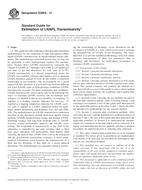
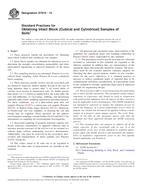 ASTM D7015-13
ASTM D7015-13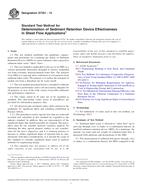 ASTM D7351-13
ASTM D7351-13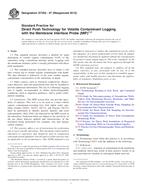 ASTM D7352-07(2012)..
ASTM D7352-07(2012)..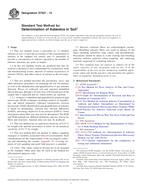 ASTM D7521-13
ASTM D7521-13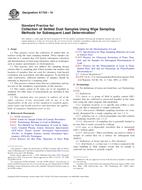 ASTM E1728-10
ASTM E1728-10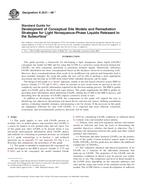 ASTM E2531-06e1
ASTM E2531-06e1
 Cookies
Cookies
